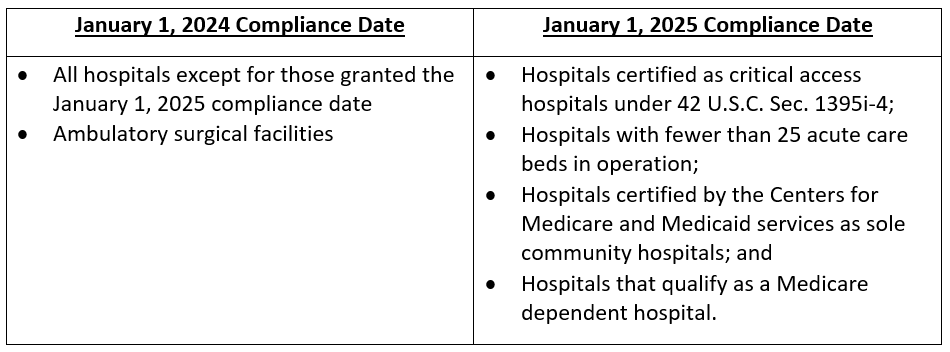Change of Law Hospital Action Required
| To: | Rural Chief Executive Officers, Chief Medical Officers, Legal Counsel, Risk and Compliance and Government Affairs Staff |
| Staff Contact:
|
Remy Kerr, MPH, WSHA Government Affairs
RemyK@wsha.org | 206.216.2514 |
| Subject: | New Surgical Smoke Evacuation Requirement Beginning January 1, 2024 or January 1, 2025 |
Purpose
The purpose of this bulletin is to inform hospitals and health systems about Washington State’s new surgical smoke evacuation law in RCW 49.17.500. The law requires hospitals and ambulatory surgical facilities to adopt policies that require the use of a smoke evacuation system for planned procedures. Hospitals must comply by either January 1, 2024 or January 1, 2025, depending on their size and type.
Applicability/Scope
The new law in RCW 49.17.500 applies to “health care employers,” which the law defines as:
- Hospitals as defined in RCW 70.41.020; and
- Ambulatory surgical facilities as defined in RCW 70.230.010.
The compliance deadline for the law is staggered by facility type and listed as a note to RCW 49.17.500:

Recommendations
- Review this bulletin alongside RCW 49.17.500 to understand the law’s requirements.
- Begin planning for compliance by reviewing and updating current hospital policies.
- Evaluate your smoke evacuation system equipment needs and purchase items as necessary.
Overview
Background
Many surgical procedures generate smoke through incision cauterization through lasers or other electrosurgical tools. According to research cited by the National Institute for Occupational Safety and Health (NIOSH), smoke generated through surgical procedures often contains “toxic gases, vapors and particulates, viable and non-viable cellular material, viruses, [and] bacteria.” NIOSH also notes that surgical smoke “has a repulsive odor and can obstruct the surgeon’s view of the surgical site.” The Occupational Safety and Health Administration (OSHA) advises, “Local smoke evacuation systems have been recommended by consensus organizations, and may improve the quality of the operating field. Employers should be aware of this emerging problem and advise employees of the hazards of laser smoke.”
RCW 49.17.500– Adoption of policies requiring the use of a smoke evacuation system during a surgical procedure
Despite the challenges posed by surgical smoke and OSHA’s advisement noted above, the use of surgical smoke mitigation equipment is inconsistent among surgeons and hospitals. Because of this, the Washington State Legislature passed HB 1779 (2022) to require the adoption of policies that require the use of surgical smoke mitigation equipment.
The full text of RCW 49.17.500 is:
- A health care employer shall adopt policies that require the use of a smoke evacuation system during any planned surgical procedure that is likely to generate surgical smoke which would otherwise make contact with the eyes or respiratory tract of the occupants of the room.
- The health care employer may select any smoke evacuation system that accounts for surgical techniques and procedures vital to patient safety and that takes into account employee safety.
- The department shall ensure compliance with this section during any on-site inspection.
- The definitions in this subsection apply throughout this section unless the context clearly requires otherwise.
(a) “Energy generating device” means a tool that performs a surgical function using heat, laser, electricity, or other form of energy.
(b) “Health care employer” means a hospital, as defined in RCW 70.41.020, or an ambulatory surgical facility, as defined in RCW 70.230.010.
(c) “Smoke evacuation system” means equipment designed to capture and neutralize surgical smoke at the point of origin, before the smoke makes contact with the eyes or the respiratory tract of occupants in the room. Smoke evacuation systems may be integrated with the energy generating device or separate from the energy generating device.
(d) “Surgical smoke” means the by-product that results from contact with tissue by an energy generating device.
- The department may adopt rules as necessary to administer this section.
Reimbursement Opportunity for Certain Hospitals
HB 1779 also created the Surgical Smoke Evacuation Account in RCW 49.17.505. If funded by the legislature during the 2023-2025 biennium, the account will provide eligible hospitals a one-time reimbursement of up to $1,000 per each operating room brought into compliance with the law. Hospitals eligible for the reimbursement are:
- Hospitals certified as critical access hospitals under 42 U.S.C. Sec. 1395i-4;
- Hospitals with fewer than 25 acute care beds in operation;
- Hospitals certified by the Centers for Medicare and Medicaid services as sole community hospitals; and
- Hospitals that qualify as a Medicare dependent hospital.
Hospitals will be able to apply for reimbursement beginning January 2, 2025 for purchases made on or before January 1, 2025 if the account is funded in the next legislative session. L&I is responsible for establishing the application process for reimbursement. Please see RCW 49.17.505 for more information about the Surgical Smoke Evacuation Account. This potential reimbursement opportunity would apply to each operating room brought into compliance (RCW 49.17.505). The legislative account for this reimbursement opportunity has not yet been funded. There may be an opportunity in the upcoming (2024) legislative session to pursue funding the account.
Next Steps
- Hospitals should begin planning for compliance with the new law. This may include reviewing and updating hospital policies and purchasing new smoke evacuation system equipment.
- L&I will likely issue a CR 101 in mid-2023 to open rulemaking to implement the law and establish the reimbursement process. As of May 10, 2023, L&I has released a draft rule and has expressed its intent to conduct an expedited rulemaking process.
- Hospitals should determine if they are eligible for reimbursement from the Surgical Smoke Evacuation Account. If your hospital did not respond to WSHA’s fall 2022 feedback request to assess the number of hospitals seeking reimbursement, please email Remy Kerr the number of operating rooms for which you will likely be seeking reimbursement.
- WSHA will work with the legislature to ensure sufficient funds are allocated to the Surgical Smoke Evacuation Account if we receive feedback from members that this should be a WSHA priority. If your hospital supports WSHA pursuing this account being funded, please contact Remy Kerr (remyk@wsha.org).
WSHA’s 2022 New Law Implementation Guide
Please visit WSHA’s new law implementation guide online. The Government Affairs team is hard at work preparing resources and information on the high priority bills that passed in the recent legislative sessions to help members implement the new laws, as well as links to resources such as this bulletin.
References
RCW 49.17.500
RCW 49.17.505
HB 1779 (2022)
NIOSH: “Health and Safety Practices Survey of Healthcare Workers: Surgical Smoke”
OSHA: “Laser/Electrosurgery Plume”


